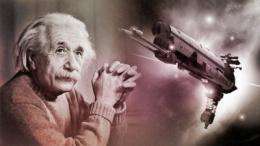Researchers proved that the two predictions for the balls trajectory can rapidly diverge and become completely different if the motion of the ball is chaotic
A simple bouncing ball has reignited a debate long thought settled: whose landmark physics theory is correct – Albert Einstein’s general relativity theory or Sir Isaac Newton’s theory of gravity?
Associate Professor Lan Boon Leong and Liang Shiuan-Ni, researchers from the School of Science at Monash University Sunway campus, showed with a system comprising a steel ball and a concave lens that the predictions of the two theories do not always agree, as conventionally expected.
In a paper published in April, the researchers proved that the two predictions for the ball’s trajectory can rapidly diverge and become completely different if the motion of the ball is chaotic.
So if the predictions are different, who is right?
Developed by the researchers, the system had the ball bouncing on a lens which was attached to the oscillating membrane of a loudspeaker. In between impacts with the lens, the ball underwent free-fall motion due to gravity (as long as the setup was housed in a vacuum chamber).
“It is very difficult to accurately calculate the ball’s trajectory using the two theories for comparison with experiment because the parameters and initial conditions of the system must be known very accurately when the motion is chaotic," Dr Lan said.
“However, since general relativity has withstood other experimental tests over the century, one would expect the general-relativistic prediction to be empirically correct. This would mean that even for low-speed weak-gravity systems, general-relativistic mechanics must generally be used, instead of the standard practice of using Newtonian mechanics to correctly study their dynamics."
Dr Lan said this paradigm shift may well lead to new understandings and discoveries for such systems.
"On the other hand, if the Newtonian prediction is correct, Einstein would surely turn in his grave. His theory would need to be corrected in the low-speed weak-gravity limit," Dr Lan said.
"Either way, there is new physics to be explored."
More information: 1. PDF: nsc10.cankaya.edu.tr/proceedin … PERS/Symp1-Nonlinear%20Dynamics%20of%20Continuous%20and%20Discontinuous%20Dynamical%20Systems/Paper7.pdf
2. Liang S-N, Lan BL (2012) Comparison of Newtonian and Special-Relativistic Trajectories with the General-Relativistic Trajectory for a Low-Speed Weak-Gravity System. PLoS ONE 7(4): e34720. doi:10.1371/journal.pone.0034720
Journal information: PLoS ONE
Provided by Monash University
























